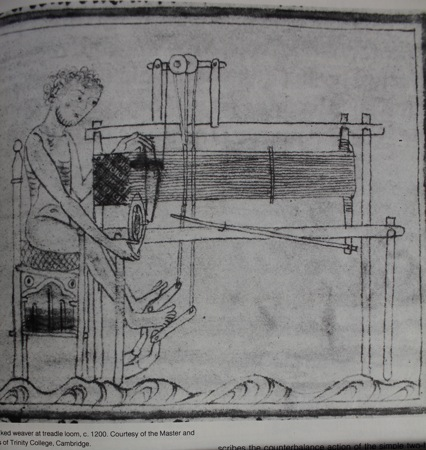Boat shuttle
« previous post | next post »
[This is a guest post by Elizabeth J. W. Barber]
A linguist friend specializing in Iranian linguistic reconstruction has a word that means weft, but also has something to do with a boat and weaving. To me, that immediately meant the "boat shuttle"–Gm. Schiffchen, Fr. navette, etc. Once the horizontal treadle loom was invented, the (flat, horizontal) shed could be opened wide enough that you could flick the weft bobbin all the way across the loom, catch it, change the shed, and shoot (shoot > shuttle) it back. HUGE time-saver!!!
The treadle loom seems to have been invented in China during the Han dynasties (206 BC-220 AD) — I can find no more than that. Don't know when some genius added the boat-shaped shuttle that floats the weft bobbin across the loom, riding atop the lower half of the warp.
The treadle loom then somehow spread across Central Asia till it reached Europe. The earliest European representation (with a rather odd change of perspective here and there) that I can hear tell of is an English manuscript from about 1100:
You see the treadles side-view; the horizontal warp, however, has been tipped so you see its top, not its side edge. In the weaver's right hand is a VERY clear top-view representation of the boat-shaped shuttle with the weft-bobbin inside, ready to be sent with a finger-flick to the other side of the loom (left hand poised to catch it and send it back).
The key question is: WHEN (and where?) was the boat-shuttle, which can only be used on a horizontal treadle loom, invented— or at least when did it reach Central Asia? We need to figure out if it reached the Iranians pre- or post- 8th century AD.
Selected readings
"The Wool Road of Northern Eurasia" (4/12/21) — with a lengthy bibliography on the importance of archeology (including evidence of weaving) for historical linguistics; this subject will come up again in our forthcoming deliberations on the Jie couplet* and related topics [*I {VHM} disagree with the Turkic and Yeniseian (Paleo-Siberian) interpretations of the couplet.]
"Archaic Greek in a modern world, part 2" (7/19/22) — Greek loom weights
"Memes, typos, and vernacular English in a 12th-century Latin homily" (7/20/25)

AntC said,
August 4, 2025 @ 11:20 pm
Makes perfect sense. And we talk of boats 'weaving' through the waves.
Michael Vnuk said,
August 4, 2025 @ 11:36 pm
I have only vaguely understood how a loom works. A quick look on Wikipedia now has helped my understanding. The extraordinary number of variations (depending on space for the loom, whether it is to be portable, what type of cloth is being woven, who is going to operate it, and so on) just remind me of the enormous complexity and specialisation of handicrafts out there.
I have several questions about the image displayed in the post. Why did the artist draw so many details on the weaver's chair? What is the significance of the wavy patterns at the base of the image. And why is the weaver naked?
DDeden said,
August 5, 2025 @ 9:21 am
I'd guess it derived from the netting shuttle:
https://youtu.be/PqDgAM_0mvA?si=s2vDKU-FJDu97Hur
The Tarim basin may have played a part in its evolution, with boat burials implying net use, and twilled fabrics?
Yves Rehbein said,
August 6, 2025 @ 12:13 am
A brief search in the library shows "The Roots of Asian Weaving" by Boudot and Buckley, Oxbow Books, 2015, ch. 7.3.9 "Weft insertion techniques"
As discussed, changes in weft insertion method are closely linked to other aspects of the loom, particularly the way in which the weft is beaten-in. The simplest and oldest system, employed on the earliest backstrap looms, is weft insertion using yarn wound around a stick, after which it is beaten-in with a hardwood sword. By the time of the development of ancestral frame looms E, F and G the weft insertion is accomplished using a beater-shuttle, which combines the functions of the shuttle and the wooden sword. The sword is correspondingly eliminated, […] [B&B 2015]